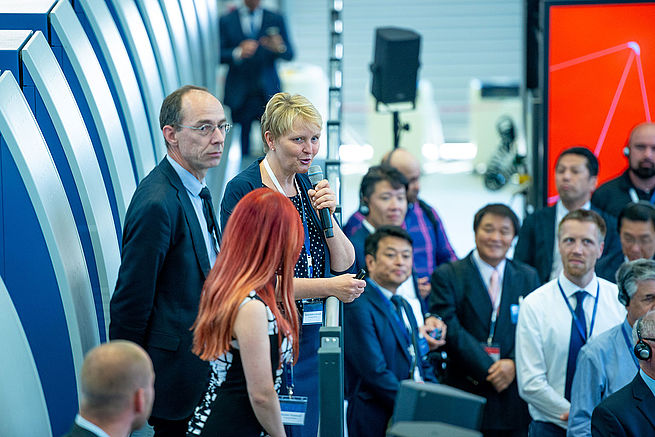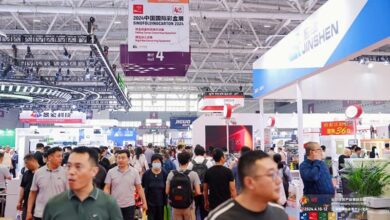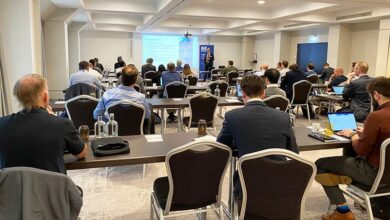Digitalisation of Business Processes Live
640 print experts from some 40 countries watched live shows

Koenig & Bauer is one of Europe’s pioneers when it comes to the digitalisation of business processes. As part of the “Koenig & Bauer 4.0 Packaging & Connected Services” open house from 6 to 8 June 640 users from some 40 countries saw how digital transformation can change modern day-to-day printing house operations, optimise process workflows, create new customer experiences and make a company even more profitable.
As part of a series of impressive live sessions, the visiting print experts experienced first-hand solutions to streamline processes in all phases of print production, Lean Management and standardisation with the goal of preventing errors. This was in addition to information on data-based value-added solutions in the field of service which make workflows more transparent and maintenance more predictable.

Ralf Sammeck, managing director of KBA-Sheetfed and executive board member of Koenig & Bauer, and Thomas Göcke, head of sheetfed marketing and CRM, welcomed the guests and highlighted Koenig & Bauer’s key success factors in sheetfed offset. These range from strategic orientation, the focus on growth areas, outstanding products and strong partners to customer satisfaction, especially through digitalisation and the resulting new service offerings. Their summary: “We bring together what moves our customers forward. The networking of people, machines and data enable new business models that make users even more profitable.”
The keynote speakers at the event were Gerriet Danz and Alexander Müller. Danz has built up a reputation over the past two decades as one of the most respected innovations experts in German-speaking countries. As creative director of the international agency BBDO he supports global players and has founded several companies himself. This year he blogged for Hamburger Abendblatt from Silicon Valley. Using examples from leading companies, he explained how creativity, collaboration, diversity and error culture contribute to developing new business models and creating added value for customers. His conclusion: “The digital shift will never again be as slow as it is today.”

Alexander Müller is an expert when it comes to digitalisation, innovations and start-ups. As CEO and owner of GEDANKENtanken he established an innovative training company together with his team. He is convinced that due to the digital revolution and exponential innovation growth, we are living in an epochal time, the effects of which we do not yet foresee.
A Rapida 76 kicked off the series of live demonstrations by printing high-quality luxury packaging in LED-UV with opaque white on metallised board. As part of a complex demonstration, the print experts witnessed seamless digital processes with MIS Optimus Dash with LogoTronic Professional and Esko Equinox on a Rapida 105 PRO which produced various packaging jobs prepared by MIS, the Ipress 106 K PRO flatbed die-cutter, the Rapida LiveApps series and service solutions such as PressCall, Visual Press Support, performance reports and the possibilities of predictive maintenance. Sven Oswald, who amongst other things is a scientific anchorman for a public-service broadcaster in Berlin-Brandenburg, brought everything together and showed the possibilities of cutting-edge data communication in a networked printing firm.

The print jobs and all necessary work steps were generated in the MIS system Optimus Dash live in front of the visiting experts. The flexibility and speed of this modern system are persuasive: from job scheduling to controlling and accounting.
After the job was created in MIS, it was sent to the Rapida 105 PRO. The press operators can see all the information forward by MIS as a JDF ticket immediately at the console. They use the job information together with the CIP3 presetting data from pre-press to automatically set-up the press. After plate changing, inking-up and inline register corrections, printing began on yogurt packaging in an extended colour gamut 6c with Esko Equinox.
The management of a printing company can access all press and operating data at anytime from anywhere, even via smartphone or tablet pc, with LogoTronic Professional and the functions PressWatch and Speedwatch. After printing has finished, LogoTronic Professional sends all production times and amounts of consumables used back to Optimus. It not only stores these times, but also press-specific notifications: every sample sheet removed, every production downtime is logged according to job. Optimus generates a cost breakdown based on the production times accumulated with just a few mouse clicks. The company can immediately see whether it is operating economically efficiently.
After the yogurt packaging, the Rapida 105 PRO printed a raft of other print jobs fully automatically. ErgoTronic AutoRun started a sequence of print jobs, using preset values, work steps and sequences set by the operator. He himself no longer has to intervene. Dirk Winkler, head of print technology, commented on the individual automatic work steps and thus made them transparent for the visitors. A glance at the MIS showed what happened on the Rapida 105 PRO in theory and practice.
One of the breakout sessions in the afternoons offered the visitors the opportunity to find out more detailed information about MIS Optimus in small groups. At the same time as print production, Koenig & Bauer presented the world premiere of the Ipress 106 K PRO flatbed die cutter for die-cutting folding cartons. It has the proven feeder of the Rapida presses. Outstanding details include integrated blank stripping, high operating comfort, absolute register accuracy, short makeready times and flexible configuration options.
At the end of the print demonstration Dirk Winkler deliberately staged an error in the sheet travel of the Rapida 105 PRO. Communication with the Koenig & Bauer hotline takes place via PressCall at the console. There’s no need to make the usual calls. All remote maintenance-relevant data can be accessed via the hotline without delay or detours. Printers and service staff use VisualPressSupport for troubleshooting. The operator sets up a video stream with the service support technician. The service technician can mark, save and store images in the video. In addition, the service specialist can display documents on the screen of the mobile device at the press to support finding a solution. All this data is documented in the CRM platform so that it is also available for future service calls.
Koenig & Bauer offers a range of other digital services based on the data supplied by the Rapida presses. Users with a remote maintenance contract and a static VPN connection (Windows platform) receive a monthly performance report that displays the performance data (non-order-related data) and KPI (key performance indicators) of their press clearly. While value-added services based on the performance data of machines installed worldwide are still in their infancy at other companies, they are already firmly established at Koenig & Bauer.
In addition to the picture of past events, the data streams from the Rapida presses can be used to proactively (e.g. to perform maintenance) and predictively foresee events. To this end, Koenig & Bauer uses artificial intelligence algorithms and optimisation methods, such as machine deep learning tools, to identify patterns for the early detection and avoidance of unplanned breakdowns and to plan for necessary maintenance.
This permanent monitoring naturally requires the user’s consent. The long-term goal is to avoid errors before they occur. The data determined by the system is available to the user in the customer portal. A further breakout session focused on high-volume packaging production in medium and large format as well as the production of luxury packaging on a Rapida 106 double-coater press and Rapida RDC 106 rotary die cutter. The highlights of high-volume printing on a six-colour Rapida 145 were print speeds of 18,000 sheets per hour and autonomous printing with AutoRun. Packaging for food and detergents was produced in non-stop operation. Conventional, low-migration inks from Huber, Actega FoodSafe dispersion coating and BillerudKorsnäs GC1 270g/m² (170lbs) board were used.
A seven-colour Rapida 106 with coater produced more folding cartons at speeds of up to 20,000 sheets per hour. Image-determining elements in 4c and 7c colour gamut were printed with Esko Equinox, so that the advantages of seven-colour printing in the reproduction of special colours could be seen on one sheet.

.gif)



